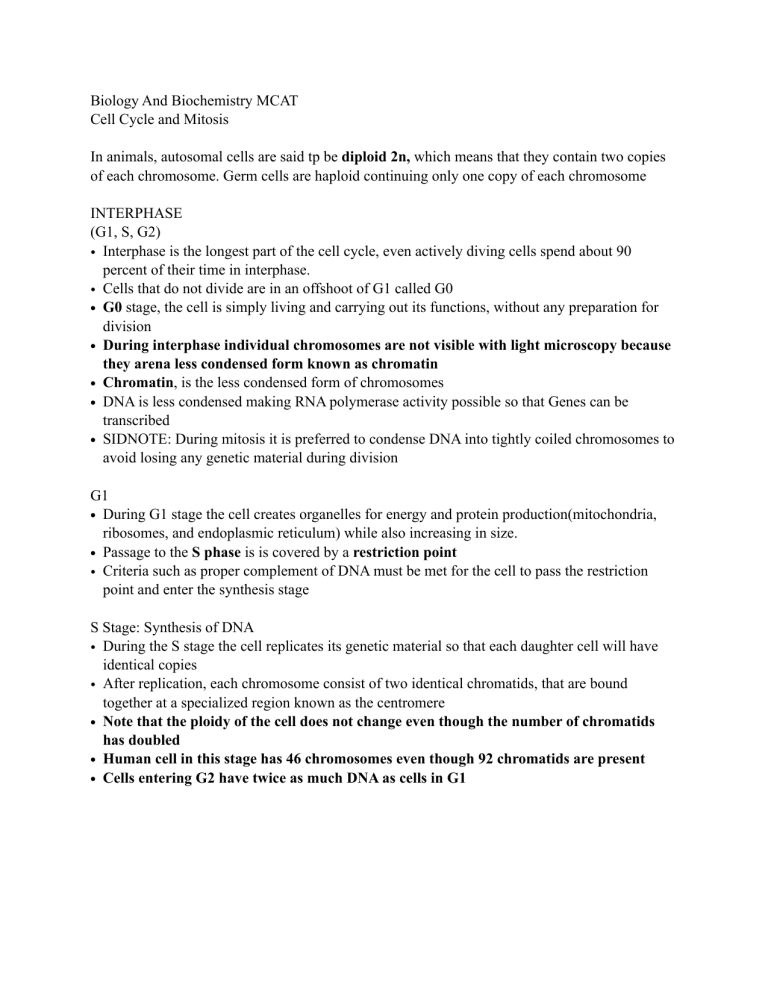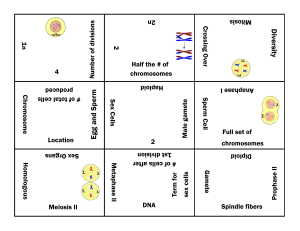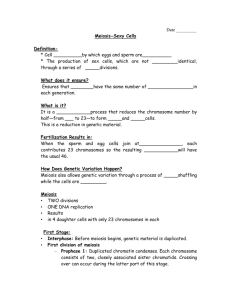
Biology And Biochemistry MCAT
Cell Cycle and Mitosis
In animals, autosomal cells are said tp be diploid 2n, which means that they contain two copies of each chromosome. Germ cells are haploid continuing only one copy of each chromosome
INTERPHASE
(G1, S, G2)
• Interphase is the longest part of the cell cycle, even actively diving cells spend about 90 percent of their time in interphase.
• Cells that do not divide are in an offshoot of G1 called G0
• G0 stage, the cell is simply living and carrying out its functions, without any preparation for division
• During interphase individual chromosomes are not visible with light microscopy because they arena less condensed form known as chromatin
• Chromatin , is the less condensed form of chromosomes
• DNA is less condensed making RNA polymerase activity possible so that Genes can be transcribed
• SIDNOTE: During mitosis it is preferred to condense DNA into tightly coiled chromosomes to avoid losing any genetic material during division
G1
• During G1 stage the cell creates organelles for energy and protein production(mitochondria, ribosomes, and endoplasmic reticulum) while also increasing in size.
• Passage to the S phase is is covered by a restriction point
• Criteria such as proper complement of DNA must be met for the cell to pass the restriction point and enter the synthesis stage
S Stage: Synthesis of DNA
• During the S stage the cell replicates its genetic material so that each daughter cell will have identical copies
• After replication, each chromosome consist of two identical chromatids, that are bound together at a specialized region known as the centromere
• Note that the ploidy of the cell does not change even though the number of chromatids has doubled
• Human cell in this stage has 46 chromosomes even though 92 chromatids are present
• Cells entering G2 have twice as much DNA as cells in G1
G2
-
The cell passes through another quality control checkpoint. DNA has already been duplicated and the cell checks to ensure that there are enough organelles and cytoplasm for two daughter cells.
-
The cells check to make sure the DNA replication proceeded correctly to avoid passing on an error to daughter cells that may further pass on the error to their progeny
Control of the Cell cycle
• Checkpoints are located between G1 and S, and S phase and G2 and M phase
• G1/S checkpint, the cell determines I the condition of the DNA is good enough for synthesis
• The main protein in control of this is p53
• At G2/M the cell is mainly concerned with ensuring that is has achieved adequate size and the organelles have been properly relocated to support two daughter cells, p53 is also important here
• Molecules responsible for the cell cycle are known as cyclins and cyclin dependent kinases(CDK)
• CDKs bind to the cyclins creating complex that can then be phosphorylate transcription factors
• Transcription factors then promote transcription of genes required for the next stage of the cell cycle
Homologous chromosomes- two homogenous chromosomes(one chromosome from mother, one from father)
In meiosis, during prophase I, the chromatin condenses into chromosomes, the spindle apparatus forms, and the nucleoli and nuclear membrane disappear. The first major difference between meiosis and mitosis occurs at this point: homologous chromosomes come together and intertwine in a process called synapsis.
At this point, each chromosome consists of two sister chromatids, so each synaptic pair contains four chromatids and is referred to as a tetrad.
Chromatids of homologous chromosomes may break at the point of synapsis, called the chiasma
(plural: chiasmata) and exchange equivalent pieces of DNA. This process is called crossing over.
Note that crossing over occurs between homologous chromosomes and not between sister chromatids of the same chromosom e (paternal and maternal chromosomes cross over, not paternal sister chromatids because this would cause no change) —the latter are identical, so crossing over would not produce any change. Those chromatids involved are left with an altered but structurally complete set of genes. Such genetic recombination can unlink linked genes, thereby increasing the variety of genetic combinations that can be produced via gametogenesis.
Linkage refers to the tendency for genes to be inherited together; genes that are located further from each other physically are less likely to be inherited together, and more likely to undergo crossing over relative to each other.
Thus, as opposed to asexual reproduction, which produces identical offspring, sexual reproduction provides the advantage of great genetic diversity, which is believed to increase the ability of a species to evolve and adapt to a changing environment.
During metaphase I, homologous pairs (tetrads) align at the metaphase plate, and each pair attaches to a separate spindle fiber by its kinetochore. Note the difference from mitosis: in mitosis, each chromosome is lined up on the metaphase plate by two spindle fibers (one from each pole); in meiosis, homologous chromosomes are lined up across from each other at the metaphase plate and are held by one spindle fiber.
During anaphase I, homologous pairs separate and are pulled to opposite poles of the cell. This process is called disjunction, and it accounts for Mendel’s first law (of segregation). During disjunction, each chromosome of paternal origin separates (or disjoins) from its homologue of maternal origin, and either chromosome can end up in either daughter cell . Thus, the distribution of homologous chromosomes to the two intermediate daughter cells is random with respect to parental origin. This separating of the two homologous chromosomes is referred to as segregation.
During telophase I, a nuclear membrane forms around each new nucleus. At this point, each chromosome still consists of two sister chromatids(that have gone through crossing over) joined at the centromere.
The cells are now haploid; once homologous chromosomes separate(during Anaphase) , only n chromosomes are found in each daughter cell (23 in humans). The cell divides into two daughter cells by cytokinesis, not four daughter cells, making answer choice (D) correct. Between cell divisions, there may be a short rest period, or interkinesis, during which the chromosomes partially uncoil.
Meiosis II is very similar to mitosis in that sister chromatids—rather than homologues—are separated from each other.
During prophase II, the nuclear envelope dissolves, nucleoli disappear, the centrioles migrate to opposite poles, and the spindle apparatus begins to form.
During metaphase II, the chromosomes line up on the metaphase plate.
During anaphase II, the centromeres divide, separating the chromosomes into sister chromatids. These chromatids are pulled to opposite poles by spindle fibe rs.
During telophase II, a nuclear membrane forms around each new nucleus. Cytokinesis follows, and two daughter cells are formed. Thus, by completion of meiosis II, up to four haploid daughter cells are produced per gametocyte. We use the phrase up to because oogenesis may result in fewer than four cells if an egg remains unfertilized after ovulation.
Male Reproductive System
In males, the primitive gonads develop into the testes . The testes have two functional components: the seminiferous tubules and the interstitial cells of Leydig . Sperm are produced in the highly coiled seminiferous tubules, where they are nourished by Sertoli cells . (D) is correct.
As sperm are formed they are passed to the epididymis , where their flagella gain motility, and they are then stored until ejaculation . During ejaculation , sperm travel through the vas deferens and enter the ejaculatory duct at the posterior edge of the prostate gland. The two ejaculatory ducts then fuse to form the urethra , which carries sperm through the penis as they exit the body.
As sperm pass through the reproductive tract they are mixed with seminal fluid , which is produced through a combined effort by the seminal vesicles, prostate gland, and bulbourethral gland. The seminal vesicles contribute fructose to nourish sperm, and both the seminal vesicles and prostate gland give the fluid mildly alkaline properties so the sperm can survive in the relative acidity of the female reproductive tract.
Cytokinesis during oogenesis is unique in that it is characterized by unequal division. Once a woman reaches menarche (her first menstrual cycle), one primary oocyte per month will complete meiosis I. This produces one primary oocyte which contains ample cytoplasm and one polar body that is largely devoid of cytoplasm and organelles. A polar body is basically a small package of DNA that is kicked off to allow for maximum cytoplasm to the secondary oocyte (or ovum in the second division). The polar body generally does not divide any further and will never produce functional gametes. The secondary oocyte, on the other hand, remains arrested in metaphase II and does not complete the remainder of meiosis II unless fertilization occurs.
Spermatogenesis is the formation of haploid sperm through meiosis, and occurs in the seminiferous tubules. In males, t he diploid stem cells are known as spermatogonia . After replicating their genetic material (S stage), they develop into diploid primary spermatocytes .
The first meiotic division will result in haploid secondary spermatocytes, which then undergo meiosis II to generate haploid spermatids.
Finally, the spermatids undergo maturation to become mature spermatozoa . Spermatogenesis results in four functional sperm for each spermatogonium.
Mature sperm are very compact. They consists of a head (containing the genetic material), a midpiece (which generates ATP from fructose), and a flagellum (for motility). The midpiece is filled with mitochondria, which generate the energy to be used as the sperm swims through the female reproductive tract to reach the ovum in the fallopian tubes. Each sperm head is covered by a cap known as an acrosome. This structure is derived from the Golgi apparatus and is necessary to penetrate the ovum. Once a male reaches sexual maturity during puberty, approximately 3 million sperm are produced per day through the rest of life.
The production of female gametes is known as oogenesis. Although gametocytes undergo the same meiotic process in both females and males, there are some significant differences between the two sexes. First, there is no unending supply of stem cells analogous to spermatogonia in females; all of the oogonia a woman will ever have are formed during fetal development . By birth, all of the oogonia have already undergone DNA replication and are considered primary oocytes. These cells are 2n , like primary spermatocytes, and are actually arrested in prophase
I. Once a woman reaches menarche (her first menstrual cycle), one primary oocyte per month will complete meiosis I, producing a secondary oocyte and a polar body . The division
is characterized by unequal cytokinesis, which doles ample cytoplasm to one daughter cell (the secondary oocyte) and nearly none to the other (the polar body). The polar body generally does not divide any further and will never produce functional gametes. The secondary oocyte, on the other hand, remains arrested in metaphase II and does not complete the remainder of meiosis II unless fertilization occurs.
If, during anaphase of meiosis, homologous chromosomes (anaphase I) or sister chromatids
(anaphase II) fail to separate, one of the resulting gametes will have two copies of a particular chromosome and the other gamete will have none. Subsequently, during fertilization, the resulting zygote may have too many or too few copies of that chromosome. Nondisjunction can affect both autosomal chromosomes (such as trisomy 21, resulting in Down syndrome) and the sex chromosomes (such as Klinefelter’s and Turner syndromes).
Down’s Syndrome occurs when a person has a trisomy at chromosome 21. This is usually due to an error in meiosis I or II where a nondisjunction event leads to unequal segregation of chromosomes. Microtubules are involved in the segregation of chromosomes during anaphase, and the malfunctioning of microtubules may lead to nondisjunction events.
Sickle cell disease is a single nucleotide mutation that causes sickled hemoglobin( which is a point mutation that could cause a frameshift mutation which is a mutation caused by insertions or deletion which changes the reading frame which can either change the protein that will be produced or alter a stop CODON (UAG, UAA, UGA)
A woman takes a pregnancy test measuring human chorionic gonadotropin (hCG) levels. The test result comes back negative. However, she is in her sixteenth week of pregnancy. Which of the following explains the false-negative result?
In pregnancy, the zygote will develop into a blastocyst that will implant in the uterine lining and secrete human chorionic gonadotropin (hCG). This hormone is an analog of LH, meaning that it looks very similar chemically and can stimulate LH receptors. This maintains the corpus luteum. hCG is critical during first trimester development because it is the estrogen and progesterone secreted by the corpus luteum that keep the uterine lining in place. By the second trimester, hCG levels decline because the placenta has grown to a sufficient size to secrete progesterone and estrogen by itself (C) . The high levels of estrogen and progesterone continue to serve as negative feedback mechanisms, preventing further GnRH secretion.
Ventilation center
• Regulates ventilation
• A collection of neurons in the medulla oblongata
• Can be controlled consciously through the cerebrum, although the medulla can override the cerebellum during extended periods of hypo or hyperventilation
Negative pressure breathing
• The diaphragm and external intercostal muscles expand the thoracic cavity, increasing. The volume of the interplureal space, which
• Decreases the intraplueral pressure
• - pressure differential ultimately expands the lungs, dropping their pressure and drawing in air form the environment
Visceral pleurae lies adjacent to the lung itself
Intrapleural space- lies between the visceral and parietal pleura and contains thin layer of fluid which lubricates the two surfaces
Kidney medulla is the deeper region of the kidney containing the loop of hence regions often nephrons
Kidney cortex is the filtering layer of the kidneys jam packed with nephrons
• Aldosterone is released and promoted during low blood pressure
• Aldosterone stimulates the kidney to retain sodium ions and water
• Aldosterone acts on Renal collecting ducts




